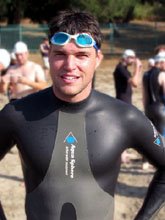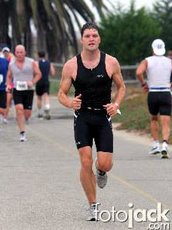Today's blog is going out to my Irish-Catholic New England cousins, of whom there are 32 (did I mention the Irish-Catholic part?). For the past few Thanksgivings, they have played a fiercely competitive annual Ultimate Frisbee match called the Marie's Cup. I played Ultimate with these guys at our family reunion last July, and they don't fool around. Just about all of them are former varsity college athletes, and the rest were star high school athletes, so getting on a field with them is nothing to be taken lightly.
I'm the youngest cousin, and I remember our family reunions fondly: my 118-pound self getting steamrolled during Ultimate games by guys like my soon-to-be-fullback-at-Brown cousin Brian, who must have weighed around 250 back then; or getting humiliatingly juked by my 6'5" other cousin Bert Jacobs, who is such a natural athlete that a few years ago he decided to do a marathon...on the day of the marathon itself (and completed it); or watching another cousin, John, roll gracefully down a steep hill while doing a handstand on a skateboard (just to see if he could do it; it wasn't something he'd ever practiced or worked at before, mind you. He could just DO IT.)
So they’re a physically gifted bunch.
Anyway, this morning I got an email from (yet) another cousin, Jim Laughlin (there are two other Jims in the family so I have to specify), asking me (and everyone else on the roster) to get in shape for the Marie's Cup tourney, which is fast approaching. Left coaster that I currently am, there's no way that I can make it to the match, though I'm flattered to be asked as I still think of myself as the nerdy runt of the litter.
I thought, however, that I could vicariously participate just a smidgen by putting together the following in-a-pinch Ultimate Frisbee Conditioning Program that might--just might--help Team Doonaree bring home the cup this year. If any of this helps even one of them make one single play in an even slightly faster, safer, or most importantly, cooler-looking way....I feel I will have done my job.
At the same time, the following can serve as a little primer in the philosophy behind conditioning program design for anyone who coaches or plays any competitive sport on a semi-regular basis.
Cousins, a lot of this will be old hat to you athletic-scholarship guys from way back, but hey, I'm my father's son, so any chance to be pedantic...
SOME THOUGHTS ABOUT CONDITIONING FOR ULTIMATE FRISBEE
1) I'm assuming that anyone attempting these workouts is already in decent shape--otherwise you probably wouldn't be contemplating competing in a physically demanding competitive sport in a few short weeks. I'm also assuming that you've got the wherewithal to stretch carefully after your workouts, and that you have a pretty good working knowledge of your own strengths and limitations, so that if I recommend something that you know will hurt, or exacerbate a previous injury, you're going to be able to modify it so that it works for you.
2) Your conditioning workouts should more or less replicate the speed, intensity, and duration of game action. This goes for conditioning for ANY sport: the basic job of a strength and conditioning coach's is to watch some games, see how long the average play or down lasts and what's demanded of the various players during each play, and then duplicate those demands in practice, preferably at escalating intensity so that the workouts becomes progressive and the players get faster, stronger, and generally more capable.
In Ultimate Frisbee, play goes on for about three minutes, followed by about a minute of rest as everyone regroups between points. So workouts should take the form of intervals that conform to a 3:1 work-rest ratio. Work for three minutes, rest for one.
All-out sprinting speed, agility, and power (for jumping), are emphasized.
Note that this means that traditional long-distance running--at a steady pace for long periods, which builds endurance at slow speeds--isn't going to gain you much. Nor is bodybuilding-style weight training, which builds strength at slow speeds in relatively nonfunctional movements. So the typical run-lift format for getting in shape isn't going to gain you much.
3) During work intervals--which you would try to structure much like the average point-- you've got short periods of jogging, interspersed with periods of 10-20 seconds of full-on sprinting, which are further broken down into numerous changes of direction, leaps, lunges and bounds, all the while shifting your focus as the disc flies to different players on the field. So your work intervals should include all three intensities: easy jogging (low intensity), sprinting (high intensity), and jumping/bounding (highest intensity).
Having said that, here’s a workout that could help improve your Ultimate-Frisbee-specific conditioning. The workout should be performed on a flat grass field—ideally the field of play itself, if you can get there. Keep a bottle of water handy and sip from it between rounds.
5 minute warmup: easy jogging, some mobility drills such as bearcrawls and inchworms: loosen up all joints. AVOID: stretches lasting more than a few seconds in duration, high-intensity efforts.
INTERVAL ROUNDS:
1) 10 second sprint alternated with 20 second jog, performed for three minutes (for a total of six ten-second sprints and six twenty-second jog).
REST ONE MINUTE
2) 15-second shuttle run, running between two objects 10 yards apart, making directional changes as quickly as possible, alternating cutting legs. Jog easily for 15 seconds between efforts. Repeat for three minutes, for a total of six shuttle-run intervals.
REST ONE MINUTE
3) Three minutes of “speed play”: jog, sprint, stride, change direction, jump at will. This round is like shadow boxing for UF. Bring the intensity down a notch from previous two intervals.
REST ONE MINUTE
4) Do three minutes of the following drill: run 10 yards, squat jump, change directions, run 10 yards, squat jump, change directions, jog 20 seconds.
REST ONE MINUTE
5) Repeat speed play round.
Cool down with a few minutes of static stretches and deep breathing.
This whole workout—warm-up and cool-down included—will take you less than a half-hour but will be very challenging for everyone (since you control the intensity with your speed and effort level, it will never become easy), and will absolutely get you in great shape for UF.
If the workouts are too difficult at first (which is likely unless you’re already in excellent shape), cut the work periods down to 90 seconds-2 minutes and work gradually up to the longer work periods. The idea is to pace yourself through each work period so that you’re not collapsing at the end of each one. Use the ‘jogging’ periods during each interval to catch your breath and relax as much as possible.
Once you get used to the format, you can design your own drills around elements of your game you’d like to improve: jumping height, foot speed, agility, hand-eye coordination. Stick with the interval-style format.
I’d suggest doing this kind of workout 3-4 times a week, always taking at least a day off between sessions.
You can also include speed drills like these at the beginning of a regular team practice.
Go Team Doonaree!
Andrew
Wednesday, November 07, 2007
Ultimate Frisbee Conditioning!
Labels:
Bodybuilding,
Interval Training,
jogging,
Marie's Cup,
Ultimate Frisbee
Subscribe to:
Post Comments (Atom)




7 comments:
Thanks for the workout tips, Andrew. We'll miss you at the Marie's Cup. Here's a poem to good memories of Frisbee and family:
The Annual Ultimate Frisbee Game at Grandpa and Grandma Heffernan's
sunny wide open Frisbee
floating across long grass
lawn beside an acre of cultivated plants,
flowers in regular rows, the lawn squared
on ends with prickled thick pine,
the end zoned shaded edges of this
once a year playing field for
sweating cousins who sprint
and bump and leap over each other in
pursuit of a sailing disk, scraping
into patches of thickets, crashing into
trees carefully somehow, knowingly, before
the group's pause of fear and then awe
of appreciation -- the player not
critically injured -- the grass-stained bare feet
sliding to a stop, the tumble and
high fives and laughter,
and the cheers from aunts and uncles
who've come around back, leaving punch bowl
and shaded glass-topped conversations, to stand
beneath Grandma's multi-roomed bird house
and bask in the hot sun
of their younger selves
Tom Laughlin
Should this workout, or similar work out be done in cleats or running shoes/trainers
Thanks for posting this. I play about once a week but I've been trying to figure out what workout actually works for a sport as unique as UF. It has seemed as though any workout I've done only where's me out and increases my recovery time from game night while doing nothing for me because it's really hard to find a workout good for doing the jumps and strides and have the energy to keep running all the time like the game requires.
Thanks for breaking it down.
this is good stuff thank you for posting this. i play 2 nights a week and have been searching for more info and ideas to increase my fitness for the game. can you please elaborate on
"Three minutes of “speed play”: jog, sprint, stride, change direction, jump at will. This round is like shadow boxing for UF"
thank you
I agree that intervals, especially those involving shuttles, sprints and lateral movement are fine for (off-season) conditioning, but to really make gains as a player, I think a more focused approach is needed.
I believe that a large part of training for ultimate should involve the weight room (with a focus on compound single leg exercises), and then there should be some kind of periodized approach with focuses on agility, sprinting technique, and plyometrics/increasing vert.
And then of course there should be some throw development, practicing breaking marks, and practicing things like continuation throws.
O! This is awesome Andrew. Thanks. And thanks to cousin Tom for the lovely poem too.
I recently made up my own version of a IF workout. I'm just getting back into the game after a long hiatus and a broken foot.
Basically, I've been tossing the frisbee at a set point like a goal post, tree, football dummy, fence, etc (trying to avoid cars, Haha!), then running for it. I use the obstacle as my "defender" and practice fancy throws. I get long and short throws, sprint and jog, up and down hills. It's all there for me. I look forward to incorporating your ideas too.
Thanks again!
Hm! Spell check! That's a U.F. workout... not an IF workout!
Post a Comment